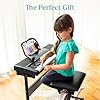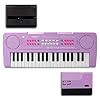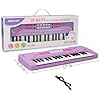Table of Contents
Introduction to Learning Piano Through Interactive Apps
The evolution of technology has transformed many aspects of our lives, including the way we learn and engage with music. Learning piano, traditionally a process requiring face-to-face lessons and substantial practice, has been revolutionized by the advent of interactive apps. These innovative platforms provide flexibility, immediate feedback, and a range of resources that cater to different learning styles and preferences. Whether you are a beginner looking to start your musical journey or an experienced pianist wishing to polish your skills, interactive piano learning apps offer a convenient and effective solution to enhance your musical prowess.
Flowkey
Flowkey is a user-friendly app ideal for beginners and advanced players seeking to enhance their piano skills. The app offers a broad selection of songs across various music genres and provides real-time feedback as users play. One notable feature is its ability to adjust to the user’s playing speed, promoting a comfortable learning pace. Additionally, its interface integrates instructional videos, ensuring users not only play correctly but also understand the music theory behind the pieces they learn.
Best Choice Products 61-Key Electronic Keyboard Piano Portable Electric Keyboard Complete Beginner Set w/LED Screen, Stand, Bench, Headphones - Black
13% OffRockJam 61 Key Keyboard Piano Stand With Pitch Bend Kit, Piano Bench, Headphones, Simply Piano App & Keynote Stickers
$129.99 (as of December 20, 2025 13:23 GMT -08:00 - More infoProduct prices and availability are accurate as of the date/time indicated and are subject to change. Any price and availability information displayed on [relevant Amazon Site(s), as applicable] at the time of purchase will apply to the purchase of this product.)Piano Star
$0.00 (as of December 20, 2025 13:23 GMT -08:00 - More infoProduct prices and availability are accurate as of the date/time indicated and are subject to change. Any price and availability information displayed on [relevant Amazon Site(s), as applicable] at the time of purchase will apply to the purchase of this product.)Keyboard Piano for Kids, BIGFUN 37 Keys Toddler Piano Multifunction Music Educational Instrument Toy, Electronic Kids Keyboard for 3-7 Year Old Girls and Boys (Purple)
15% OffSimply Piano by JoyTunes
As one of the most popular piano learning apps, Simply Piano caters to learners at all levels. The app uses the microphone to listen to your playing, providing instant feedback to improve your skills. Its curriculum is neatly organized into courses that cover essentials like reading sheet music, chords, and playing techniques. Additionally, Simply Piano’s engaging interface and structured learning path make it highly effective for regular practice.
Yousician
Yousician sets itself apart with a curriculum designed by music teachers to accommodate self-learners. The app uses the microphone to analyze your playing and gives precise, timely feedback to help correct mistakes and enhance playing techniques. It offers lessons for piano as well as other instruments, which is perfect for learners who play multiple instruments. The app’s game-like structure makes it particularly appealing to younger students and beginners.
Playground Sessions
Co-created by music legend Quincy Jones, Playground Sessions is a revolutionary app that teaches piano using popular songs. The app provides interactive feedback and ranks your progress, motivating you to improve. It also features video tutorials hosted by well-known musicians, offering various interacting learning approaches. The Playground Sessions community is another valuable resource, offering competitions and encouraging pianists to engage with and support each other.
Skooove
Skooove offers a blend of classical piano training with modern technology features. The app listens to your piano playing through the microphone and suggests improvements in timing and accuracy. Its focus on classical and contemporary music provides a balanced curriculum for students. The app also adjusts difficulty based on player proficiency, making it ideal for continuous learning. Moreover, Skooove’s flexibility in device compatibility means you can practice with any piano or keyboard.
100 of the Most Beautiful Piano Solos Ever | Piano Sheet Music Book for Intermediate Players | Classical Pop and Jazz Standards | Essential Solo Repertoire for Adult Students Teachers and Pianists
28% OffP71 Digital Piano Review and Guide
$0.00 (as of December 20, 2025 15:53 GMT -08:00 - More infoProduct prices and availability are accurate as of the date/time indicated and are subject to change. Any price and availability information displayed on [relevant Amazon Site(s), as applicable] at the time of purchase will apply to the purchase of this product.)The Piano Proficiency Exam Review Book
$26.99 (as of December 20, 2025 19:57 GMT -08:00 - More infoProduct prices and availability are accurate as of the date/time indicated and are subject to change. Any price and availability information displayed on [relevant Amazon Site(s), as applicable] at the time of purchase will apply to the purchase of this product.)Ready for Theory Prep B Review Book (Ready for Theory Piano Review Books)
$10.95 (as of December 20, 2025 15:53 GMT -08:00 - More infoProduct prices and availability are accurate as of the date/time indicated and are subject to change. Any price and availability information displayed on [relevant Amazon Site(s), as applicable] at the time of purchase will apply to the purchase of this product.)How to Integrate Apps into Your Daily Practice
Integrating interactive piano apps into your daily practice routine can significantly elevate your learning experience. To effectively incorporate these tools, consider the following approaches:
Before starting, define what you want to achieve in each session using the app. Whether it’s mastering a particular piece, improving your sight-reading abilities, or enhancing your timing, having clear goals can help you stay focused and measure your progress.
Maintaining consistency is key when learning an instrument. Schedule regular times each day dedicated to practice. Most apps offer reminders and scheduling features, so take advantage of these tools to integrate practice into your daily routine seamlessly.
Use your chosen app to engage in warm-up exercises before diving into more complex tasks. Many apps provide guided warm-ups that can help prepare your hands and mind for practice, improving both flexibility and focus.
Vary your practice by using different features within the app. Switch between learning modes, such as following along with video tutorials, engaging in ear training games, or using the metronome feature. Variety keeps your practice sessions fresh and covers multiple aspects of piano learning.
Most apps offer progress tracking and analytics. Regularly review your progress to understand your strengths and areas for improvement. This feedback is crucial for adapting your practice routine and setting more targeted goals.
As you grow comfortable with the basics, start challenging yourself with new and more complex pieces. Advanced apps often have large libraries of music. Choose pieces that align with your favorite genres or that present a reasonable challenge to keep learning exciting.
Many interactive piano apps feature a community component where you can share your progress and get feedback. Engage with other learners to exchange tips and experiences, which can enhance your motivation and exposure to diverse learning methods.
While apps are a valuable tool, they should ideally be used to supplement traditional learning methods. Consider combining app sessions with lessons from a teacher or self-study with books to ensure a well-rounded approach to piano education.
Gamification: Making Piano Learning Fun
Integrating gamification into piano learning apps has transformed the traditional methods of musical education, making it more engaging and fun for users of all ages. Here, we explore various aspects of gamification and how they enhance the learning experience.
Real-Time Feedback and Progress Tracking
Real-time feedback is a crucial aspect of gamified learning apps. These apps provide immediate input on performance, helping learners correct mistakes and refine their skills on the spot. Additionally, progress tracking through graphical representations of achievements keeps learners motivated by visibly showing how much they have improved over time.
Interactive Challenges and Rewards
Interactive challenges engage users by introducing various difficulty levels and new pieces to master. Successfully completing these challenges often unlocks rewards like badges or points. This not only makes the learning process enjoyable but also stimulates a healthy level of competitiveness.
Leveling Up and Mastery
Applying a leveling-up system encourages continuous learning and improvement. As learners achieve higher levels, they unlock more complex pieces of music, which maintains their interest and pushes their limits. The sense of mastery achieved after conquering difficult levels is a powerful motivator.
Community Features and Sharing
Many piano learning apps now incorporate community features where users can connect with one another. Sharing progress, challenges, and performances within a community can lead to a more enriching learning experience, providing both support and challenge from peers.
Customized Learning Paths
Customization is another key element of gamification. Users can choose their own paths based on their interests and skill levels. Such personalized experiences make learning more relevant and intriguing, as learners feel the curriculum is tailored specifically for them.
Tracking Progress with Apps
Modern piano learning apps incorporate various analytics and tracking tools to monitor a user’s progress, providing insights into areas such as time spent practicing, accuracy of notes played, and progression through different levels and pieces. These metrics are often visualized through dashboards and progress bars, which help learners see a clear picture of their achievements and areas requiring more attention.
Another key feature is the ability for users to record their sessions. This functionality not only allows learners to listen back to their performances and identify mistakes but also helps track improvement over time. Some apps integrate video playback features, enabling users to analyze their posture and hand positioning.
Feedback mechanisms are also integral, with many apps offering instant feedback on each session. This could include correcting the timing, pitch accuracy, or even suggesting finger positioning, hence providing a comprehensive, real-time review that guides the learner effectively.
Setting Goals with Apps
Goal setting in piano learning apps is designed to be user-centric, allowing learners to set short-term and long-term objectives. Apps typically provide templates for common goals such as mastering a piece, improving sight-reading skills, or achieving a certain number of practice hours per week.
Customizability is a key aspect, with learners being able to modify goals according to their personal learning pace and target outcomes. Users can create milestones within the app, which serve as motivation and provide a structured learning path. Many apps also offer the ability to set reminders and notifications which help maintain a regular practice schedule.
Some apps integrate gamification elements such as rewards and badges for completing specific goals or challenges. This approach not only makes the learning process more engaging but also adds a level of motivation and excitement to the educational journey. Integrating these gaming elements helps keep students engaged and often accelerates the learning process by making practice sessions both fun and rewarding.
Finding the Right App for Your Skill Level
When choosing a piano learning app, it’s crucial to select one that matches your current skill level, whether you’re a beginner, intermediate, or advanced player. Each level requires a different set of features and teaching methods to effectively enhance your skills.
For beginners, the app should focus on the fundamentals of piano playing. This includes basic music theory, simple melodies, and understanding musical notation. Apps like Simply Piano or Flowkey provide guided lessons that introduce these concepts at a gentle pace. Beginners require an app with interactive step-by-step tutorials, easy songs, and real-time feedback to ensure correct finger placement and timing.
Intermediate players should look for apps that offer an expanded song library and more complex pieces that challenge their skills while continuing to build on the basics. An app like Skoove adjusts to your skill level, offering pieces that require more hand coordination and the use of both treble and bass clefs. These apps often include features such as different playing styles and the introduction of more advanced music theory, which are crucial for developing versatility and a deeper musical understanding.
For advanced pianists, the ideal app should offer a vast repertoire including classical, jazz, and contemporary pieces, and allow customization of exercises to target specific skills. Apps like Piano Marvel or Playground Sessions can be beneficial. They provide advanced sheet music options, intensive drills, and features that let users record and listen to their performances, which is essential for honing advanced skills and preparing for performances.
Conclusion
Interactive apps have undeniably transformed the landscape of learning piano, making it more accessible, flexible, and engaging for students of all ages and levels. The ability to learn at one’s own pace and the incorporation of gamified elements help maintain motivation and interest. Though these apps may not replace traditional methods entirely, they serve as valuable supplements, enhancing the educational experience and offering effective practice tools.






































